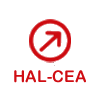Simulating auto-irradiation of glass using external irradiation beams: impact on glasses structure and properties
Résumé
In the current context of nuclear waste management, the fission products and minor actinides are vitrified in a borosilicate matrix and intended for long-term disposal in a deep geological repository. After several thousands of years, groundwater is expected to resaturate the clay host, then corrode the metallic canister and encounter the glass packages. The long-term behavior of glass under these conditions needs to be studied to guarantee the right containment of radionuclides. Glass self-irradiation is a key parameter because it impacts the glass properties and thereby its behavior [1]. Alteration experiments conducted on radioactive glasses are cumbersome to carry out, as they have to take place in hot environments (glove boxes or shielded cells). Therefore, external irradiations are used to simulate the impact of self-irradiations on the glass structure and properties [2]. Nuclear glasses will suffer from both electronic and nuclear damages, due to alpha and beta disintegrations, and to gamma transitions.
In this work, the structural changes for different irradiation scenarios of a complex SON68 type glass as well as its equivalent simple glass ISG are studied. The effect of different couplings between nuclear and electronic interactions for different electronic stopping power Se are simulated by Au and He ions and electron irradiations. 2.5 MeV electron irradiations simulate the damage of beta and gamma radiations at saturation of effects. 7 MeV Au irradiations and 2 MeV He simulate the damage of the recoil nuclei of alpha decays and alpha particles respectively. Au irradiations induce mainly nuclear interactions with matter while the electron and He irradiations lead to electronic interactions, except at the end of the path for He, but correspond to different stopping powers (higher for He than for electrons). Sequential irradiations are performed to reproduce the coupling effect of these different interactions, leading to 8 to 12 irradiation scenarios depending on the glass used (Figure 1). The modifications on the structure and properties of the glass (swelling, hardness) are determined by several characterization technics like Raman spectrometry, Fourier Transform Infrared Spectroscopy, micro-indentation and optical interferometry [3].
Domaines
Matériaux| Origine | Fichiers produits par l'(les) auteur(s) |
|---|


